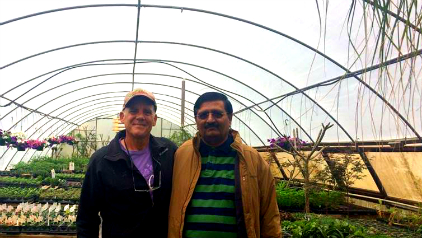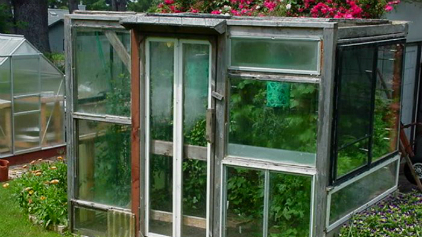According to the Garden Helper's Dictionary, a micro-climate can
be thought of as 'variations of the climate within a given area, usually
influenced by hills, hollows, structures or proximity to bodies of
water.'
So what does this mean, and how can it affect gardening and land-
scape projects around your home?
It could mean that it's a lot colder (or warmer) where you live, com-
pared with the next town, or the next street . . . or even just 10
away from your chosen planting spot.
Gardeners should greet this as wonderful news. Once you begin to
understand some of the intricacies of micro-climates, it will allow
you to get away with 'daring' experiments with plants that normally
would not survive in our climate.
For example, there are several citrus trees around town that surviv-
ed into the teens during the chilly Jan. 7 weekend with little damage.
Some were planted facing south, up against a tall building which
protected them from the north wind, allowing them to benefit from
the heat retained in the building's exterior walls.
To help readers understand this fascinating subject, here are six
micro-climate concepts.
_____________________________________________________
1. Urban Heat Islands: buildings, roads and other concrete struc-
tures within cities absorb heat all day; they then release this warmth
slowly at night, and raise the average night temperatures compared
to the surrounding outer edges of the city. Notice how Camp Mabry’s
low temps are always several degrees warmer than readings from
the airport. Since I live in the Round Rock city 'proper,' I can get
away with more tropical plants at my house than my parents, who
live south in Buda.
_____________________________________________________
2. The Effect of Large Bodies of Water: If you live near a lake or
pond or the ocean, you'll notice a high moisture level and humidity
in the air. On the plus side, this moderates temperatures of the surrou-
nding area, but it also makes everything seem a little 'sticky.' The
effects of this extra moisture are most pronounced in coastal areas
and large lakes and can create its own weather, i.e. The Great Lakes
region 'lake-effect' snow storms.
_____________________________________________________
3. Cold air sinks: The higher you live on a hill, the warmer in gen-
eral you will be relative to the valley beneath you. Even small hills
can make a difference. The last killing frost we had about 10 years
ago saw agaves frozen solid at the bottom of my street; those of us
at the top of the hill had little damage.
_____________________________________________________
4. Compass Points: Different sides of your home (or even a privacy
fence) can have very different temperatures in both the summer and
winter. Dig in plants that need cooler temps year round on the east
or north side of the house. Put plants in need of extra winter protec-
tion on the west or south side. This way they'll get as much heat in
the winter as possible and protection from the killing north winds.
_____________________________________________________
5. Exposure: Plants planted out in an exposed area will feel fluctua-
tions in temperature more intensely than those set closer to a struc-
ture. For example, it's better to plant something with larger leaves
that may suffer sunscald when facing west or south or damage from
north winds along an opposite facing wall. It is also easier to offer
plants some protection from afternoon summer heat by keeping
them closer to a north or east facing wall, fence or even a taller
plant.
_____________________________________________________
6. Reflective surfaces: Lighter colors, including concrete, painted
surfaces and limestone, reflect more heat than darker ones. In the
summer this heat bouncing back on to a plant could cook sensitive
leaves on a 100 degree day leaving them brown on the edges with
pale, washed out spots in the inner areas. Alternatively, these same
places can be a life-saver for heat tolerant plants that need extra
winter heat.
_____________________________________________________
Armed with this knowledge, you should hopefully be able to add
greater diversity to the collection of plants in your landscape as you
explore the peaks and the valleys and protected areas around your
home. Happy micro-climate gardening everyone!❦






